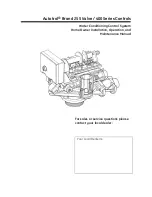
INSTRUCTIONS
1. Remove the strainer from the bottom of the pump by depressing the lock tabs on both sides
of the pump.
CAUTION: Strainer must be properly installed before attaching and running the pump to
prevent any foreign material from entering and damaging pump components.
2. Determine a suitable mounting location for the pump. If only one pump is being used, locate
it in the vessels bilge where the deepest level of water will gather. While the vessel is at rest,
the installation must allow for complete drainage of the bilge pump
’s outlet hose. All water
pockets must be eliminated by having the outlet hose running level or continuously upward.
3. Position the strainer so that the pump outlet nozzle is in the correct position to connect the
outlet hose.
4. Mounting the strainer:
• If attaching the strainer to wood, fasten with stainless steel screws.
• If attaching the strainer to metal or fiberglass, first mount a wooden block and then fasten
strainer to the wooden block using stainless steel screws. Marine grade sealant can be used
for mounting the wooden block to the vessel.
5. Mount the pump on the strainer so that both lock tabs snap into place. (The pump may be
reversed on these tabs if necessary.)
6. Attach the outlet hose to the outlet nozzle of the pump, Flexible hose is recommended for the
outlet pipe, to prevent any kinks if sharp bends are unavoidable.
NOTE: If you are replacing a previous bilge pump that has a smaller diameter outlet hose, you
may need to use an adapter to connect to the larger outlet size on the pump.
Restricting the flow from the pump by using a smaller hose will not damage the pump,
however you will reduce the rated flow capacity.
7. Through hull fittings:
• For most installations, install a through hull fitting to achieve the rated capacity of the pump.
Locate the through hull fitting at least 30cm above the water line to prevent water from
flowing back into the hull when the pump is switched off.
•
For stern installations, place the through hull fitting high enough in the stern so that it cannot
be submerged under any conditions.
8. Wiring:
•
In order to prevent electrolysis and corrosion to wiring connections, its essential that all wire
ends and terminals be located above the highest possible water level by fastening with
insulated staples or cable ties.
•
Using wire that is too small, or running over an extended distance will result in excess heat in
the wiring, resulting in voltage drops and lower performance of the pump.
9. Fusing:
•
To protect your electrical wiring and automatic switch from possible overload install a fuse in
the positive (+) lead from the battery. We recommend to use a completely sealed, waterproof
fuse holder.
•
If using a panel switch with a fuse holder, check to see that the proper fuse is being used,
you may wish to install a panel switch with a built-in fuse holder.


























